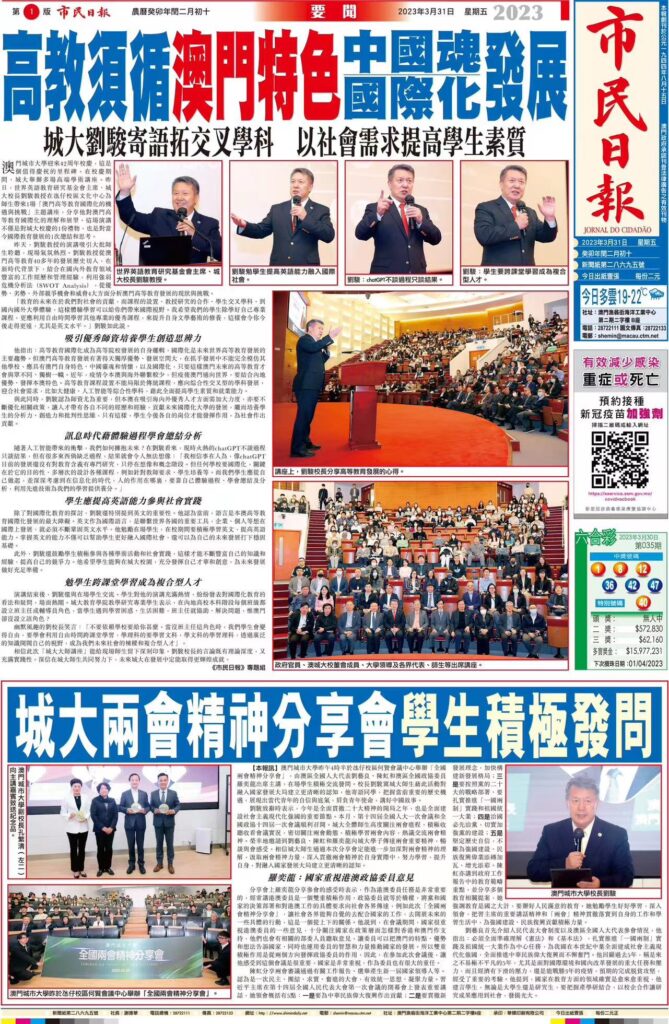Dear TIRF Colleagues and Friends:
Upon returning to Macau after our productive TIRF Board meeting and invigorating TESOL Convention activities in Portland, Oregon in late March, I devoted my time and energy to the 42nd anniversary of City University of Macau as its Rector. The week-long celebration featured three speeches: “Reality in Literature,” by one of the leading figures in cotemporary Chinese literature; “ChatGPT and its Social Function,” by one of the top scholars in this field; and “Opportunities and Challenges in Internationalization in Macau Higher Education,” by me. I laid out the parameters and shared my perspectives based on my years of experiences working in higher education administration in various contexts. I would like to share with you some of my thoughts here.
To me, internationalization in higher education refers to the intentional process of integrating an intercultural or global dimension into the purposes, functions, and delivery of post-secondary education, in order to enhance the quality of education and research for all students, faculty, and staff, and to make a meaningful contribution to society. Internationalization on campus can be reflected in at least the following 10 dimensions:
- The campus has been widely internationalized across colleges, schools, divisions, departments, programs, and disciplines.
- There is evidence of genuine administrative and/or board-level support for internationalization.
- The campus-wide internationalization has a demonstrative impact on students.
- The institution’s mission statement contains an explicit or implicit statement regarding internationalization and/or global learning.
- The institution supports education abroad as well as its international faculty, scholars, and students.
- There are programs and initiatives that are innovative and/or creative in their approach to campus internationalization.
- The institution’s commitment to internationalization includes faculty and is reflected in the curriculum.
- There is an international dimension in off-campus programs, community engagements, and successful strategic partners.
- There is internationalization in research and/or faculty exchange.
- Students from the institution have global mindsets.

Among the above-mentioned dimensions, four conditions are most critical to ensure the success of campus internationalization. First and foremost, we must have institutional support including stated institutional commitment, organizational structure and staffing, and external funding. Secondly, we must have academic requirements, programs, and extracurricular activities that include language requirements and offerings, international/global course requirements, education abroad, use of technology for internationalization, joint or dual degrees, and campus activities. Thirdly, we must have faculty policies and opportunities that include funding for faculty opportunities and criteria for promotion, tenure, and hiring. Finally, we must have a substantial international student body, including exchange and visiting students as well as those who study abroad built into enrollments, recruiting targets and strategies, financial support, programs, and support services.
Too often, many institutions lack a comprehensive international strategy. Many campuses do not have adequate senior-level staff support for internationalization, and many students do not see internationalization as integral to their identity or career strategy. Obviously, a gap exists between institutional rhetoric (as espoused in mission statements) and polices and actions that encourage global and collaborative research among faculty, and global and experiential learning among students by designing programs and offering internationally or globally required courses.
To enhance campus internationalization, we need to build on student interest and demographics, focus on curriculum, invest in faculty opportunities, create a strategic framework for actions, ensure active leadership in making internationalization an institutional priority, and focus on global learning outcomes and assessment. However, in the contexts where English is not official or mandatory in the curriculum across campus, internationalization is difficult to realize. In a similar vein, if Macau, where only Chinese and Portuguese and are official languages by law, wants to advance its internationalization agenda, the role of English as a global language, as an international language, or as lingua franca needs to be reassessed in Macau context.
As part of TIRF’s work, we seek to support language education approaches and policies that have a positive effect on the contexts involved. The internalization of higher education presents a unique challenge for many institutions worldwide. Over time, TIRF will play a role in advancing this effort, as part of its organizational focus, and we invite you to assist us in these efforts.
Kind regards,

Jun Liu, PhD
President, TIRF

